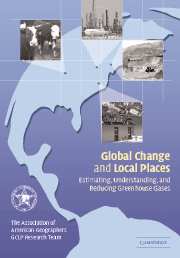Book contents
- Frontmatter
- Contents
- List of contributors
- Foreword
- Preface
- Acknowledgments
- Part One Global change and local places
- Part Two Learning from localities
- 3 Global change and Southwestern Kansas: local emissions and non-local determinants
- 4 Northwestern North Carolina: local diversity in an era of change
- 5 Northwestern Ohio: re-industrialization and emission reduction
- 6 Global change and Central Pennsylvania: local resources and impacts of mitigation
- Part Three Beyond Kyoto I: greenhouse gas reduction in local places
- Part Four Beyond Kyoto II: greenhouse gas reduction potentials and strategies
- Index
- References
5 - Northwestern Ohio: re-industrialization and emission reduction
Published online by Cambridge University Press: 31 July 2009
- Frontmatter
- Contents
- List of contributors
- Foreword
- Preface
- Acknowledgments
- Part One Global change and local places
- Part Two Learning from localities
- 3 Global change and Southwestern Kansas: local emissions and non-local determinants
- 4 Northwestern North Carolina: local diversity in an era of change
- 5 Northwestern Ohio: re-industrialization and emission reduction
- 6 Global change and Central Pennsylvania: local resources and impacts of mitigation
- Part Three Beyond Kyoto I: greenhouse gas reduction in local places
- Part Four Beyond Kyoto II: greenhouse gas reduction potentials and strategies
- Index
- References
Summary
Toledo and its region attracted the attention of the Global Change and Local Places project because of their centrality in the traditional urban–industrial heartland of the United States. The area has undergone profound changes during the Global Change and Local Places study period. Its heavy involvement in fossil-fuel use in industry and the greenhouse gas emissions from such establishments place Northwestern Ohio at the core of the national search for ways to reduce greenhouse gases.
From 1970 to 1990, the 23-county study region of Northwestern Ohio accomplished a 26% decline in greenhouse gas emissions because of a complex combination of technological and structural forces. Perhaps the key ingredient was the industrial sector's responses to federal and state enforcement of more stringent air pollution controls mandated by the Clean Air Act. A second factor resulting in reduced emissions was local industrial restructuring brought about by changes in the broad region's general economy. Intensive intra-regional competition developed in the 1990s between greenfield industrial developments in the rural and suburban counties and to a lesser degree renewal efforts for brownfield redevelopment in core urban areas (Bielen 1998). That regional competition led to redistribution of greenhouse gas emissions from core urban zones to suburban and rural areas. Industrial restructuring will most likely continue to determine the magnitudes and locations of future greenhouse gas emissions in Northwestern Ohio. Adoption of energy-efficient production technologies will temper growth in greenhouse gas emissions despite continued industrial growth.
- Type
- Chapter
- Information
- Global Change and Local PlacesEstimating, Understanding, and Reducing Greenhouse Gases, pp. 103 - 121Publisher: Cambridge University PressPrint publication year: 2003
References
- 2
- Cited by



